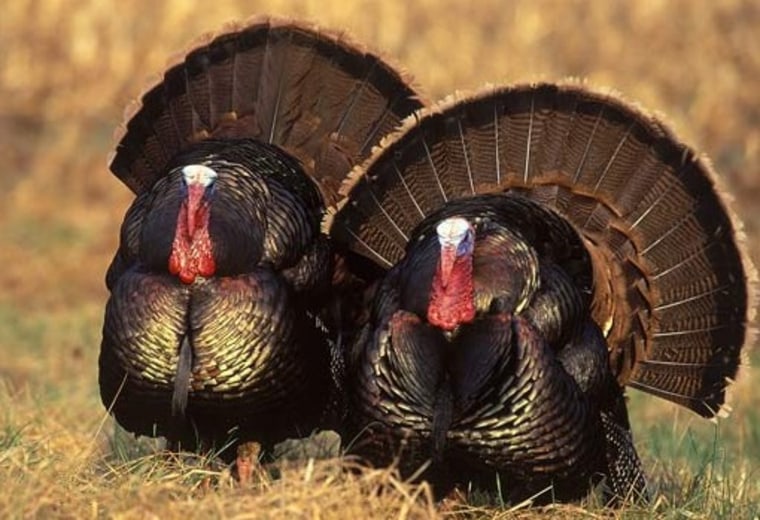The great majority of today's domesticated turkeys may not be able to fly, but their ancestors sure got around. The quintessential New World bird, Meleagris gallopavo, was already an Old World favorite by the time colonists in North America first celebrated any Thanksgiving feasts. Today's turkey researchers are investigating the big bird's genetic heritage and biology as part of an effort to improve several aspects of its cultivation.
In 2010, a team of researchers from numerous labs in the United States announced the sequencing of more than 90 percent of the turkey genome. This represented a big step in turkey research, but efforts continue.
"Once you identify genes, the next step is to figure out what they do," said Rami Dalloul, a poultry and immunology researcher at Virginia Polytechnic Institute and State University in Blacksburg.
"What we've been doing for the past almost year is building upon that sequence and trying to figure out, are there traits in the original [wild] bird that might be useful for today's bird?" said Julie Long, a poultry researcher at the research arm of the U.S. Department of Agriculture in Beltsville, Md.
The researchers have been working with the genetic material from the most popular domesticated commercial breed, the broad breasted white turkey. It is descended from turkeys domesticated in modern Mexico by predecessors of the Aztecs. The birds were well-established as a food source by the time the Conquistadors arrived. The Spanish took the birds back to Europe, and they quickly spread across the continent.
"Very quickly the domesticated turkey became, as far as I could tell, the real first New World food to be adopted in Europe," said Andrew F. Smith, a food historian and the author of "The Turkey: An American Story."
"When the Pilgrims and when the Jamestown colonists arrived, they had already eaten turkey," Smith said.
Smith said that by the 1550s, turkeys were already popular at Christmas dinners in England. When colonists came to the New World, they found large populations of wild birds that provided a reliable food source.
Colonists eventually began raising turkeys, but did not domesticate the wild birds.
"The commercial birds that we eat today were actually developed in the United States," said Long. "But they were developed on stocks that came from Europe that originally came from Mexico."
A whole different breed
After hundreds of years of breeding, today's commercial turkeys are far removed genetically from the wild turkeys from Mexico, which were already isolated from any of the five subspecies of wild turkeys found in the United States today.
The genetic sequence of the domestic turkey differs from its wild turkey relatives, and can be used to illustrate differences between the animals.
"Once you have the baseline, which is the domestic turkey, then you have a good reference genome to come back to and then make a valid comparison," said Dalloul.
Wild turkeys have a gene that makes them resistant to a type of toxic fungus sometimes found in corn and soybeans. This toxin can be deadly on its own or lower a turkey's resistance to other infections and cause death that way.
The domestic breed no longer carries that resistant genetic trait.
"If you can bring back that gene into the domestic population, then you can have these birds again more resistant to [the toxin]," said Dalloul.
No natural mating
Even the intended consequences of commercial turkey breeds have introduced complications. Breeders developed birds with more white meat. The resulting turkeys, such as the broad breasted white, grow muscle quickly, and, as the name suggests, that muscle is concentrated in the breast area.
"[The breast] protrudes quite a bit and physically gets in the way when the birds need to reproduce," said Long. "In the commercial turkey industry there are no birds that naturally mate."
The great majority of turkey farmers must therefore depend upon artificial insemination, said Long. She suggested that there may be rare exceptions among small farms raising older breeds of turkeys, called heritage breeds, which may reproduce naturally. Artificial insemination is a laborious job in turkey facilities, as the sperm from male toms must be collected and female hens inseminated weekly.
"The amazing thing about the turkey hen is she's capable of keeping viable sperm cells for up to ten weeks after a single insemination," said Long. "The best we can do and still maintain high levels of fertility is about six hours."
If turkey researchers could find a way to increase the amount of time that they can store sperm for later use, it might make the process of artificial insemination easier and less time-consuming. This is a primary area of research for Long, who hopes that further study of molecular DNA may help explain other reproductive issues as well, including why some hens lay more eggs than others.
More Thanksgiving science:
- Top 5 surprising turkey facts
- Thanksgiving's a newcomer as autumn fests go
- How evolution led to the rise of cranberries
- It's OK to play with your Thanksgiving food in space
Chris Gorski is a writer and editor for Inside Science News Service. This report was originally published as "The Globe-Trotting Turkey" on the InsideScience.org website.
